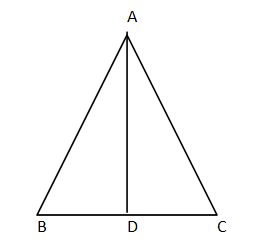
In the figure, $ABC$ is a triangle in which $\angle ABC < 90^\circ $ and $AD \bot BC$. Prove that $A{C^2} = A{B^2} + B{C^2} - 2BC.BD$.


Answer
576.9k+ views
Hint: Here we are given that $AD \bot BC$. So we got two right angled triangles. So using the Pythagoras theorem in the $\Delta ABD$
$A{B^2} = A{D^2} + B{D^2}$ and in the triangle $ADC$, we get that
$A{C^2} = A{D^2} + D{C^2}$
Complete step-by-step answer:

In the given figure in the triangle $ABC$ where $\angle B < 90^\circ $
To prove: $A{C^2} = A{B^2} + B{C^2} - 2BC.BD$
And$AD$ is the product such that$AD \bot BC$. Therefore we have got two right angled triangles.
Here we get that $AD \bot BC$.
So now in$\Delta ABD$
$AD \bot BC$ so $\angle ADB = 90^\circ $
So we can use the Pythagoras theorem where
${({\text{hypotenuse)}}^2} = {({\text{base)}}^2} + {{\text{(perpendicular)}}^2}$
In$\Delta ABD$
$A{B^2} = A{D^2} + B{D^2}$$ - - - - - (1)$
In $\Delta ADC$
$AD \bot BC$
So $\angle ADC = 90^\circ $
Hence we get that
$A{C^2} = A{D^2} + D{C^2}$$ - - - - (2)$
Now we substitute $DC = BC - BD$ and also the value got from (1)
So putting these in the equation (2), we get
$A{C^2} = A{B^2} - B{D^2} + B{C^2} + B{D^2} - 2BC.BD$
So we get that
$A{C^2} = A{B^2} + B{C^2} - 2BC.BD$
Hence proved.
Note: In the right angled triangle we use the Pythagoras theorem. In that right angled triangle, the side opposite to the $90^\circ $ is considered as hypotenuse of that triangle and we can use Pythagoras theorem as ${({\text{hypotenuse)}}^2} = {({\text{base)}}^2} + {{\text{(perpendicular)}}^2}$
$A{B^2} = A{D^2} + B{D^2}$ and in the triangle $ADC$, we get that
$A{C^2} = A{D^2} + D{C^2}$
Complete step-by-step answer:

In the given figure in the triangle $ABC$ where $\angle B < 90^\circ $
To prove: $A{C^2} = A{B^2} + B{C^2} - 2BC.BD$
And$AD$ is the product such that$AD \bot BC$. Therefore we have got two right angled triangles.
Here we get that $AD \bot BC$.
So now in$\Delta ABD$
$AD \bot BC$ so $\angle ADB = 90^\circ $
So we can use the Pythagoras theorem where
${({\text{hypotenuse)}}^2} = {({\text{base)}}^2} + {{\text{(perpendicular)}}^2}$
In$\Delta ABD$
$A{B^2} = A{D^2} + B{D^2}$$ - - - - - (1)$
In $\Delta ADC$
$AD \bot BC$
So $\angle ADC = 90^\circ $
Hence we get that
$A{C^2} = A{D^2} + D{C^2}$$ - - - - (2)$
Now we substitute $DC = BC - BD$ and also the value got from (1)
So putting these in the equation (2), we get
$A{C^2} = A{B^2} - B{D^2} + B{C^2} + B{D^2} - 2BC.BD$
So we get that
$A{C^2} = A{B^2} + B{C^2} - 2BC.BD$
Hence proved.
Note: In the right angled triangle we use the Pythagoras theorem. In that right angled triangle, the side opposite to the $90^\circ $ is considered as hypotenuse of that triangle and we can use Pythagoras theorem as ${({\text{hypotenuse)}}^2} = {({\text{base)}}^2} + {{\text{(perpendicular)}}^2}$
Recently Updated Pages
Master Class 9 Social Science: Engaging Questions & Answers for Success

Master Class 9 Science: Engaging Questions & Answers for Success

Master Class 9 English: Engaging Questions & Answers for Success

Master Class 9 Maths: Engaging Questions & Answers for Success

Master Class 9 General Knowledge: Engaging Questions & Answers for Success

Class 9 Question and Answer - Your Ultimate Solutions Guide

Trending doubts
Which places in India experience sunrise first and class 9 social science CBSE

Fill the blanks with the suitable prepositions 1 The class 9 english CBSE

Write the 6 fundamental rights of India and explain in detail

Difference Between Plant Cell and Animal Cell

What is pollution? How many types of pollution? Define it

What is the Full Form of ISI and RAW




